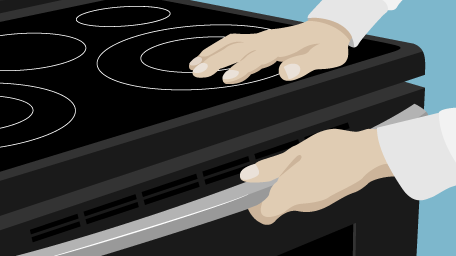
How to Clean Your Flat Top Range
Spills happen. If you’re able to cook an entire meal without any drips or messes, please share your wisdom! For the rest of us, cleaning up after a meal is inevitable. If you catch them quickly, most dribbles are easy to wipe up. It's when food gets burnt onto the cooktop that the challenge begins. If you’ve ever had a pot of pasta boil over, you understand the struggle. We're sharing a variety of techniques and products you can use to ensure that your glass or ceramic cooktop is as clean and shiny as the day you bought it.

Using Commercial Products
In the cleaning product aisle of your local store, you’ll be able to find a couple of different options made specifically for glass and ceramic cooktops. These products are typically either a cream for deep cleaning, or a spray for daily use. The cream-style cleaners may have a gritty texture, but they are a non-abrasive formula for removing burnt-on spills from your cooktop. The cleaner is poured onto the surface, and then spread out using a soft cloth or paper towel. Buff the product in to remove any stains or build-up from the cooktop. Finish up with a soft dry cloth to polish the stovetop to a shine.

When using a daily spray cleaner, you can use one specifically made for cooktops, but you may also be able to use a glass cleaner or a regular household cleaning product. Check your manufacturer’s guide to be sure that these products will be suitable for your style of cooktop. The spray-on cleaner is a great choice for wiping up after daily use, keeping the cooktop clean and shiny.

Heavily Stained Range Tops
If your dinner bubbled over, you may have some stubborn burnt-on stains to deal with. Your regular cleaning spray may not be able to handle this, so we’re turning to alternative methods. Good ol’ baking soda and white vinegar are a great duo for breaking down the burnt-on mess. Simply sprinkle the surface with baking soda, and spray it with vinegar. Let that solution sit for 10-15 minutes.

If more food ended up on your cooktop than on your plate, you may need to add an extra step. Soak a washcloth in very hot water and wring it out. Place the cloth on top of the vinegar solution and let them sit. After 15 minutes, use the cloth to scrub the surface and the build-up should now wipe right off.

Using Dry Powdered Cleaners
A similar method to using baking soda, powdered household cleaners also work well on smooth cooktops. Dampen the surface, and then sprinkle with the powder cleaner. Again, with any stubborn spots, a hot damp cloth can be placed over the powder. Then after 10-15 minutes the surface can be wiped up and polished to a shine. This type of cleaner should be safe for glass cooktops, but you will want to be mindful of the surrounding surface areas. They may be too abrasive for stainless steel or plastic, so check the information on the product label and consult with your owner’s manual.

Scraping Stubborn Stains
If you’ve tried all the above methods and there’s still a burnt-on mess, it’s time to bring in some tools. Specifically, a scraper blade. Once again, there are scraper products made specifically for cleaning cooktops, and they’re designed to get the job done without injuring yourself or damaging the surface. Make sure that the cooktop has cooled completely before you begin. Spray the stain with either water, vinegar, or cleaner to moisten it. You will want to use a fresh sharp blade and hold the scraper at a 45-degree angle, then carefully work at removing the buildup. Once the worst of it has been scraped away, you can clean up the rest using one of the previously mentioned techniques.

Of course, the best way to prevent stubborn burnt-on stains is to clean up any spills when they happen. However, we realize messes happen, and hot burners can prevent quick cleanups. Hopefully these tips and techniques make it easier to clean up your cooktop the next time spills happen. If you’ve discovered that you need some replacement parts for your range, we have you covered. Simply search for your model number on our site for everything you need to get it working like new again.




























